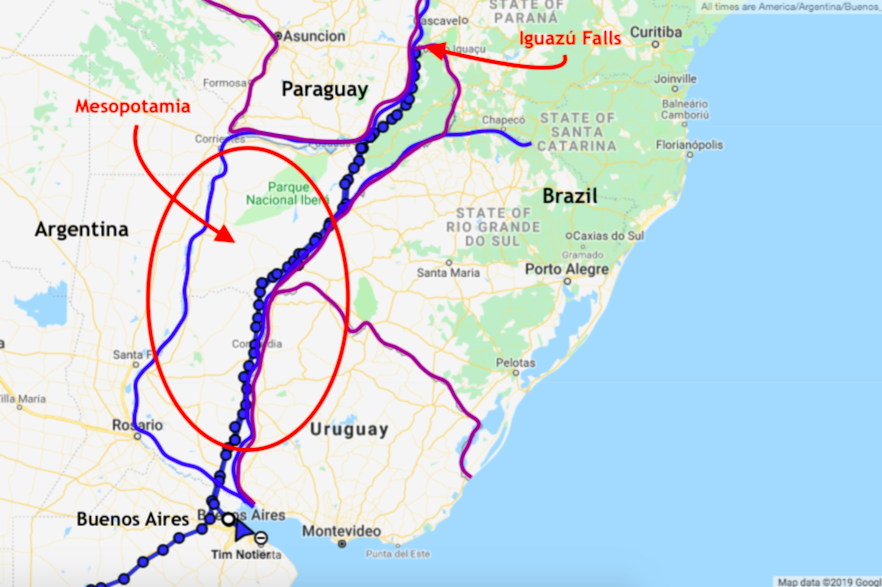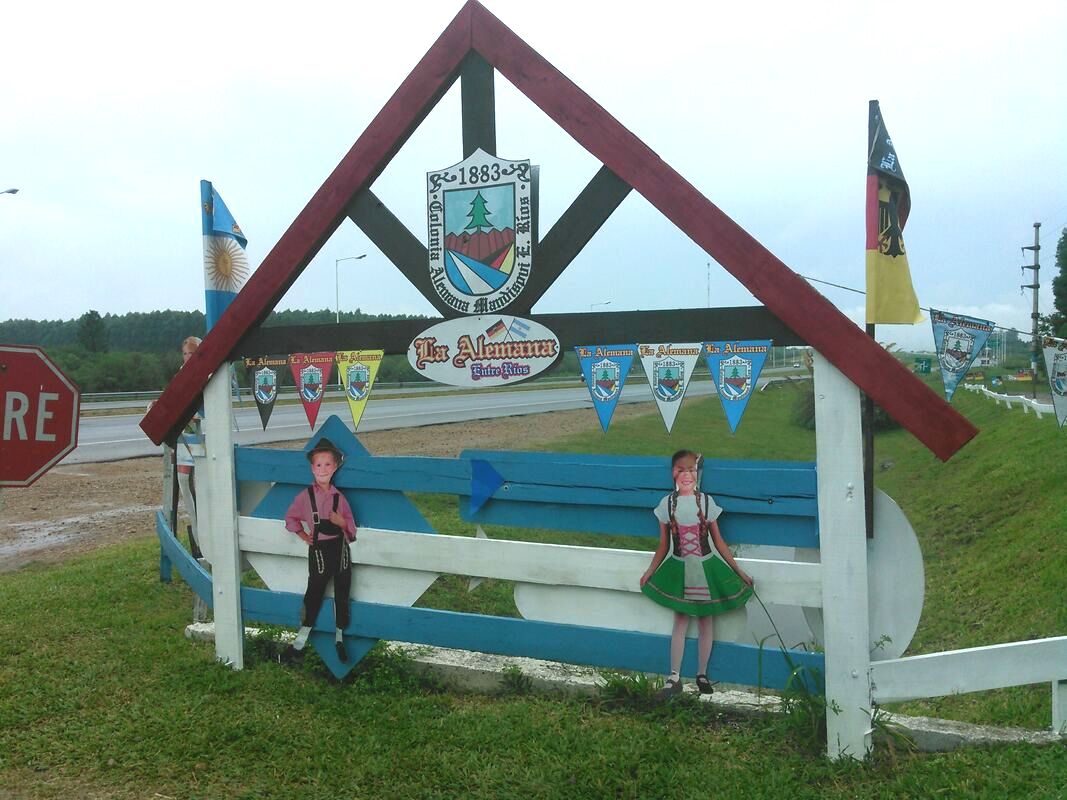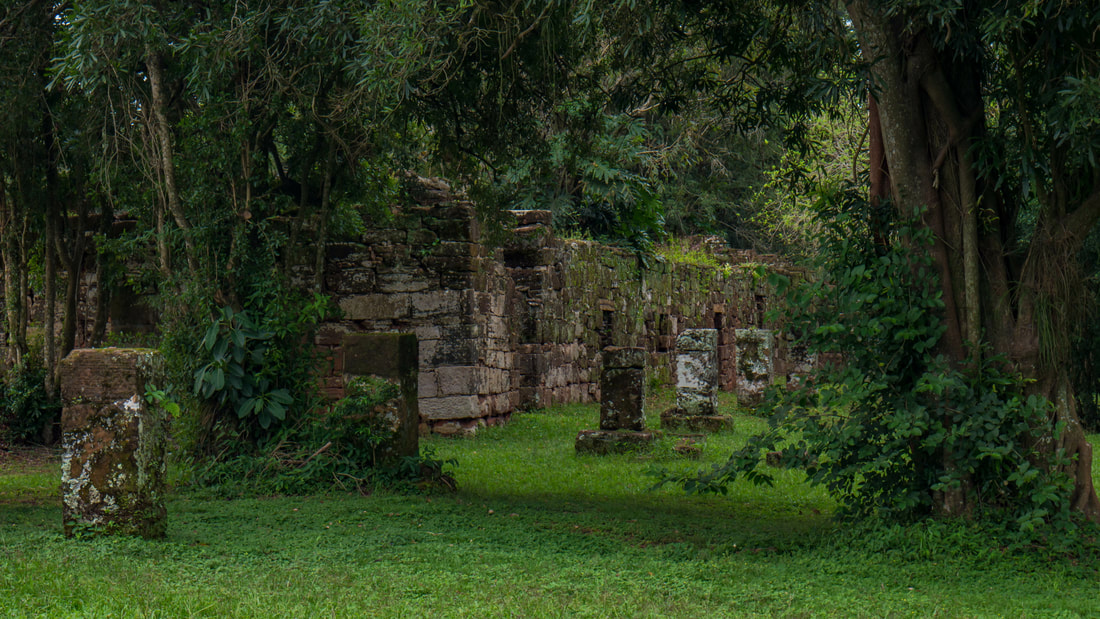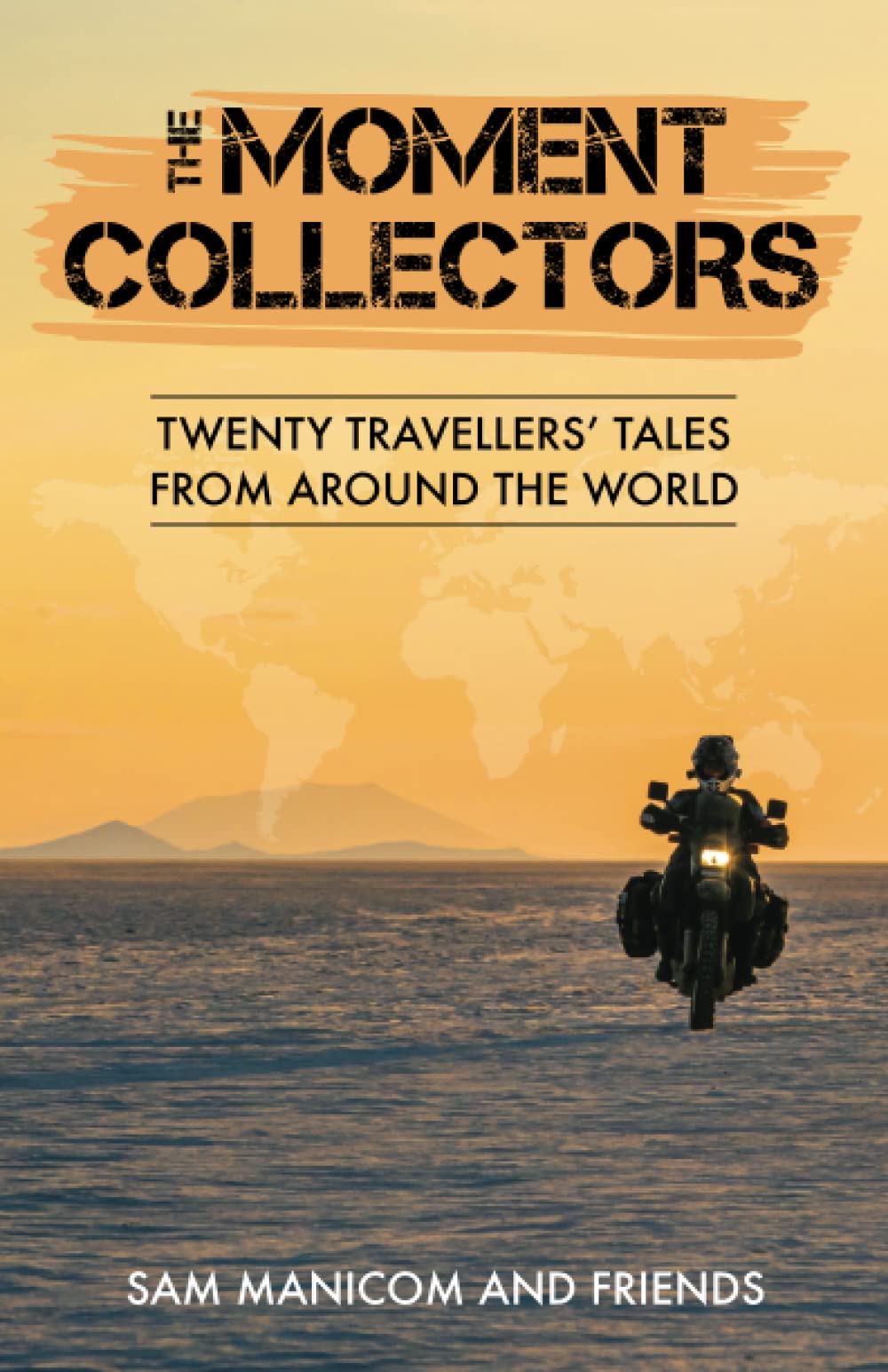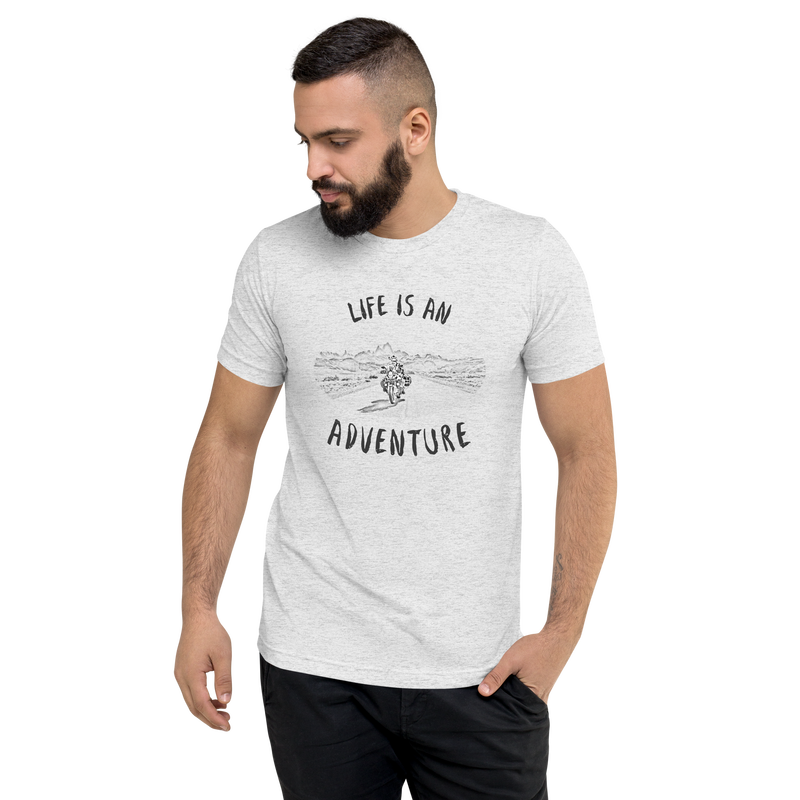By MarisaAs I write this sitting on my dorm bunkbed in Buenos Aires, I'm coming to the gut-stabbing realization that this is the end. Well, at least it's the end of South America for us. Because in a few days we fly ourselves and our bike back home to Chicago for a few months' rest before we then head on to Africa. But as I reflect on all that we've seen and done not just in the past two years of travel, but also in the past two weeks here in Argentina, I know that at least we ended our Great Americas Journey with a bang. Or a splash I guess I should say. We were coming into central Argentina from the southern reaches of Patagonia, and we arrived in a mountainous, alpine area known as Argentina's Lake District. Our first stop was to set up camp in Los Alerces National Park (350 Pesos per person, ~$8), named after the ancient cypress trees that grow there. Often compared to the sequoias in the US, some alerce trees are more than 3,600 years old and are some of the oldest living organisms on earth! The place feels like an untamed and crisp wilderness, like you could be lost somewhere in the Colorado Rockies. We took a gorgeous winding dirt road through the park that ran along mountainsides with views of glittering blue lakes below us. And that night we found a camp spot with a view out our tent window of fish jumping out of the crystal clear water of a glacial lake. Pretty hard to beat. After Los Alerces NP, we headed deeper into the Lakes District which is famous for its Swiss-looking towns such as El Bolsón, La Angostura, San Martín de los Andes, and the region's urban and tourist center, San Carlos de Bariloche. These towns felt clean, friendly, wealthy, and quaint with their wooden and stucco houses of high-pitched roofs boasting shuttered windows and flower boxes. And if that's not great enough, the town centers were lined in sweet-smelling German bakeries and chocolate shops. These places definitely have an old-world European feel, and though the chocolate is divine, one should keep in mind that this is still modern Argentina, and that these structures and cities are all very new compared to the original ski towns of the Alps. And for all their charm, sometimes it can feel like a movie set version of the real thing. We spent our last few days in the Lakes District taking random scenic dirt roads through the mountains, and wild camping next to pristine rivers. It was idyllic (except for a punctured tire, but Tim's a pro at fixing them now), and I would highly recommend these roads to anyone willing to get off the beaten-path (Rte 65 and 63 between Bariloche and San Martín, and Rte 23 north of San Martín). Our last night camping started off fine, but by morning it was so icy, we decided that summer had definitely abandoned us in this part of the world, and that it might be time to stay in a warm hotel instead. With the Lakes District now behind us, our plan was to get to Buenos Aires on the other side of the continent as quickly as we could, which turned out to be a four day ride. There's really not much to see or do in the windy pampas grasslands that is the entirety of middle Argentina. Just wave to the gauchos on horseback herding their cattle as you pass. It's a little like the Midwest, where we're from, except instead of corn fields as far as you can see, it's just grass. Barbed wire fences and grass. And maybe a grazing animal or two. And wind. There's something austere and comforting about it all, for sure, especially since it reminds me of home. But it's also terribly boring. The closer we got to Buenos Aires, the more like the Midwest it became: rolling corn, soy, and wheat fields surrounding the occasional giant metal grain cooperative. And then we came to maybe the friendliest town in Argentina: Pehuajó (peh-wa-HO). There's not anything particularly special about Pehuajó, except that I felt like I had entered a “Leave it to Beaver" episode and found myself in 1950's Perfectville, USA. Because as Tim was putting more oil in the bike (we still have a leak) and cleaning out the air filter right in downtown Pehuajó, people started gathering around. Sure, he and the bike are definitely attention-grabbing, but you would have thought everyone's long-lost cousin had showed up. So many people were coming up to him and talking, giving him their number for if he needed any help, inviting us to join their motorcycle club, we even got invited to someone's 80th birthday party! There were children playing on the street, people riding by on bicycles with little bells, the owner of the hotel greeted every person who walked by with a smile and by name. There was even a woman on a bike with her baby swaddled into the front basket (probably not the safest thing, but hey, it's 1950's America, nobody cared!). The opthamologist across the street kept coming by to make sure we didn't need any of the tools he had, the woman next door gave me a map of the region, it was so much friendliness, that this tiny town with not much there will forever stay in my heart and memories. From Pehuajó, we had a choice to make: go straight to Buenos Aires, or first go to these incredible waterfalls we'd heard about called Iguazú (ee-gwa-SU). The obvious choice would be to see the waterfalls if they're supposed to be so great, but the problem is that it's a long journey to get there. Like if it's your dream in life to visit Paraguay, then they would maybe make sense to see (poor Paraguay, I doubt that's anyone's dream), but otherwise you have to go days out of your way to see these waterfalls. Our bike had an oil leak along with some other issues that needed attention, so there were plenty of reasons to get to Buenos Aires to fly home as soon as possible. On the other hand, even though most people might have never heard of Iguazú Falls, it's one of the largest and most spectacular waterfalls in the world, and is more than twice the height and width of Niagara. It has been a bucket list item of mine for years, and so despite it not making sense when considering finances and time, I told Tim that it would mean a lot to me if we went. Tim had very little interest in the falls, but out of a favor for me, we headed north to Iguazú. It was a four day unpleasant journey through a humid and rainy landscape called Mesopotamia, an homage to the fact that like the Fertile Crescent, it's also wedged between two major rivers: the Uruguay and the Paraná. Full of timber and yerba mate farms, the flat views of never-ending green stretches can be interesting at first, but it didn't take more than a half hour before I started to wonder if any waterfall could ever make this worth it. After a few days on the road, we started to see signs for something called La Alemana (the German Woman), and not just one sign, but an incessant amount of signs. Have you ever driven through South Dakota and seen all the signs for Wall Drug? There's nothing else to look at and you just can't tune out the obnoxious billboards, until you find yourself actually anticipating whatever this proclaimed amazing business is. Well, like we expected, La Alemana is a kitsch German-themed store that sells hamburgers, pickles, sausages, and cheeses, complete with a fake windmill and waterwheel. But I found myself actually surprised by the quality of the products. They're supposedly all made by 24 local German-ancestry families, and I really enjoyed my jar of chicken escabeche, which is like a vinegar preserve with meat and veggies, mmmm! They even had wild game versions made with ñandú (ostrich-like local birds), viscacha (chinchillas), pheasants, llama, and all sorts of animals I had no idea what they were. After La Alemana, we were sure we weren't going to see anything of even the slightest interest until the falls. But when we arrived in the town of San Ignacio, we checked into our hotel and the owner asked us if we knew how to get ruins. “Ruins?" I asked. She said, “Oh. You didn't come here to see the ruins?" It turns out we were only a few blocks away, and as we are avid Indiana Jones wannabes, we knew we had to check it out. On the way there, I kept thinking, “What sort of South American civilization made huge stone ruins in this part of the Amazon jungle?" And then once we got there I realized that even though these ruins were old for American standards (from 1632), they were not indigenous. The San Ignacio Miní mission was built by Spanish Jesuits (costs 270 Pesos a person, ~$6.15), and despite not being quite as mysterious as Incan and Mayan temples, they were still very impressive and had their own sort of mystique to them. The red stones carved into ancient Greek and Roman designs contrasted against the rich and savage jungle green, the detailed carvings of mermaids and griffons above the doorways, and the sheer size of the structures really made me feel like we had stumbled upon a hidden treasure. And the trees! The massive trunks supporting a web of vines... one tree had been completely consumed by an invading cactus, another tree had a different tree growing right through the middle of it. And the best part for us were the areas where the jungle had taken over, like this was the lost city of Angkor Wat. It was oppressively hot with the clouds holding all the moisture to the ground like they wanted to suffocate us, but that all sort of added to the adventure of the place, like we were two sweaty explorers who had found El Dorado. The next day we pulled our bike into Puerto Iguazú (the Argentinian town closest to the falls), we found a hotel, and hoped that the weather would hold for our next day's trip into the National Park. But I was nervous, not just about the weather, but I was afraid that this was all going to be a disappointment. I knew that no matter what, I would be grateful for Tim bringing me there, but I worried that I'd regret having convinced him to take so much time and money just to see a waterfall. That he would sigh and say to me afterwards, “Ok, so we did that. Can we go home now?". Part of the problem is that we wouldn't be going to the Brazilian side of the falls. Although the entirety of Iguazú Falls is technically in Argentina, Brazil has a fantastic lookout point (poor Paraguay, again... so close, but they somehow missed out on all the action). But it would cost us even more time and money to enter Brazil, and we had decided against it. So whatever Argentina had to offer, that was going to be what we got. We woke up on the day of truth to see rain-filled clouds above us. Great. I started to get the sense that this was going to be a disaster.  This is what Iguazú Falls looks like on Google. It seems almost like a volcano, which sort of makes sense since it was actually created by an ancient volcanic explosion. The other crazy part is, what you see here is just one section of the falls, and the rest is completely covered by that huge constant plume of mist. The park cost us 700 Pesos a person (~$17.50), plus 70 for parking (~$1.60), and once we got inside, we had to get tickets (free) for a train that would take us to the main attraction: La Garganta del Diablo, or Devil's Throat. The train was crowded and slow, but as we started hiking along a congested metal walkway over the river, feeling squished and herded along like I was stuck in line at a Disney World ride, I noticed a thick mist forming over the river in the distance. And then as we got closer, there was this constant roar. And before we knew it, we were standing on a platform actually built over the largest part of the waterfall! It was loud, wet, and intense, like we were inseparable from the water, a part of the action, feeling like we were about to tumble over! It was a thrilling experience, but as far as views go, you couldn't see much besides the rushing water beneath you because everything else was shrouded in the mist it created. So we left the Devil's Throat, now with smiles on our wet faces, got back on the packed and sweaty train, and made our way to a trail that was said to be the best: the Lower Circuit. In Spanish, this trail is called El Paseo Inferior, which, as opposed to the Paseo Superior, did not sound like it was going to be better. But sure enough, once we trekked through the dark and humid rainforest, we arrived at an opening with a view that just erased any doubts I may have had. After a good ten minutes of awed silence and picture taking, Tim turned to me and said, “Now this is worth it. This is amazing!" And I could have cried. Except that he wouldn't have noticed from all the rain on my face. Yes, it was raining, but I realized that it didn't matter. After all, we were in the rainforest and we had come to see water, lots of it. But also the ferocity of the clouds seemed to fit right in. Those deep tones of the grumbling sky against the angry water hurtling itself over the edge and punching its way down against the rocks, that whole battle scene was in perfect contrast with the ballet dance of the bridal veils of singular streaming falls on either side, like delicate silk threads becoming lost in the wispy forest foliage. If I had to describe a place like heaven with all its strength and beauty wrapped into one, it would be simply this image of Iguazú Falls, and the feeling I felt as I stood there marveling at its grandeur. We hiked both the Lower and Upper Circuit trails that go beside, over, and even under countless waterfalls. And there wasn't just the view of the main falls, but there were falls all around us, behind us, plunging below the walkways, each and every one would have been an attraction in and of itself if it were anywhere else. I have to say that this National Park really puts your money to hard work. Most of the trails are metal walkways built over rivers and wetlands, and they have done a fantastic job. As you walk the miles of grated boardwalks, you will see huge fish and stoic egret beneath you, and you'll really appreciate how it was no easy feat to create these trails. There are bathrooms, benches, garbages, recycling bins, food stores, handicapped-accessible ramps to nearly everything, and best of all, friendly employees standing around guiding people and giving directions. For being a water-laden site in the middle of thick Amazonian jungle, they've really made it easy and comfortable to get to. Even the slow train is ok, I suppose. So, was it worth it? Yes! And I hope that the name Iguazú becomes a household name for one of the world's great natural wonders. We rode back east to Buenos Aires (stopping at La Alemana again for more German chicken-in-a-jar), and yesterday we had a marvelous time exploring this dynamic city of culture, arts, food, music, and dance. Buenos Aires is a beautiful city with a posh atmosphere that somehow feels relaxed at the same time. I mean, steaks and wine and tango and museums and nightlife, this historic city is always vibrant, always having a good time, and always awake (probably due to all the mate drinking). But now it's time for us to go back home. Don't worry, the trip is not over! First we'll ride our bike out to Flagstaff, Arizona to give a presentation at the Overland Expo West on May 17-19 (we hope to see you there!). And we'll also be getting married in June! Whoa, that's a big one. And then, off to Africa! So lots of exciting stuff to come, stay tuned and we'll keep you updated here, on facebook, and instagram. Join us on YouTube! |
Follow UsRide with us from Chicago to Panama!
2Up and Overloaded Get inspired by the tale that started it all:
Maiden Voyage 20 author's tales of exploring the world!
The Moment Collectors Help us get 40 miles further down the road with a gallon of gas!
Become a Patron for early access to our YouTube Videos!
Subscribe to our YouTube Channel!
Subscribe to our Blog by Email
|
2Up and Overloaded
Join our clan of like-minded adventurers...
Proudly powered by Weebly
Designed by Marisa Notier










